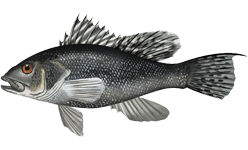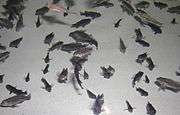Black sea bass
| Black sea bass | |
|---|---|
 | |
| Black sea bass | |
| Scientific classification | |
| Kingdom: | Animalia |
| Phylum: | Chordata |
| Class: | Actinopterygii |
| Order: | Perciformes |
| Family: | Serranidae |
| Genus: | Centropristis |
| Species: | C. striata |
| Binomial name | |
| Centropristis striata (Linnaeus, 1758) | |
The black sea bass (Centropristis striata) is an exclusively marine grouper found more commonly in northern than in southern ranges.
It inhabits the coasts from Maine to northeast Florida and the eastern Gulf of Mexico. The three large biomass populations of black sea bass are the mid-Atlantic stock, from Cape Cod in Massachusetts to Cape Hatteras in North Carolina, the South Atlantic stock, from Cape Hatteras to the southern tip of the Florida peninsula, and the Gulf of Mexico stock, from the southern tip of the Florida peninsula to Texas. They can be found in inshore waters (bays and sounds) and offshore in waters up to a depth of 130 m (430 ft). They spend most of their time close to the sea floor and often congregate around bottom formations such as rocks, man-made reefs, wrecks, jetties, piers, and bridge pilings.
Lifecycle
The sea bass spawns when it is mature, at 190 mm (7.5 in), in middle of May to end of June. The buoyant eggs are 0.95 mm (0.037 in) in diameter, and their development time is 1.6 days at 23 °C (73 °F). The maximum size of a sea bass is 500 mm (20 in), weighing 4.3 kg (9.5 lb).
It appears off New Jersey in the first weeks of May, withdrawing in late October or early November, and wintering offshore at 55 to 130 m (180 to 427 ft) at temperatures above 8 °C (46 °F). In summer, it is most abundant at less than 37 m (121 ft).
Black sea bass are protogynous hermaphrodites, meaning they generally first mature as females and some later become male. The sex change generally occurs over the winter when the fish are 240 to 330 mm (9.4 to 13.0 in) long.[2][3]
The world record catch for the black sea bass is 4.65 kg (10 lb 4 oz), caught Virginia Beach, Virginia, USA 01-Jan-2000, by Allan Paschall.[4]
Identification features
- The spiny and soft ray portions of the dorsal fin are continuous, so there is only one long fin instead of two short separate ones as for the wreckfish Polyprion americanus, scup Stenotomus chrysops, rose fish Sebastes marinus, cunner Tautogolabrus adspersus, or striped bass Morone saxatilis.
- Rounded caudal fin and pectoral fins, and short but high anal fins are present.
- Compared to a tautog or cunner, its mouth is much larger; also, the caudal fin, pectoral fin, and soft portion (11 rays) of the dorsal fin are as long as spiny portion.
- Compared to a wreckfish, its scales are much larger, the head outline and gill cover are smooth, and the caudal fin is rounded at the edges.
- It is stout-bodied, three times longer than tall (without caudal fin), and has a high back, flat-topped head, moderately pointed snout, large, oblique mouth, eyes set up high (not as high as in the above image due to its slightly oblique perspective), and one sharp, flat spine near the caudal end of the operculum.
- The dorsal fin originates at the anterior of the caudal end of the operculum, the soft portion of the dorsal fin is more tall than long, the caudal fin is rounded and in adults it is an elongated upper ray, and the anal fin originates below the soft portion of the dorsal fin, which it resembles in its rounded shape and being more tall than long.
- The pectoral fin is very long nearly towards the anal fin, and rounded (best fieldmark); the pelvic fin is very large and originates posterior of pectoral fin (whereas it is slightly caudate in scup, rose fish, cunner, and striped bass, or below in wreckfish).
- Scales are very large, but it is naked at the head, with adult males developing fatty bumps in front of the dorsal fin.
It often rests stationary or cruises slowly around structures. It occasionally rests on the bottom or other structures, staying either head-down or head-up. It enters the smallest corners and caves with a body angle above ground often about 40° down. The dorsal fin is normally folded close to the body, and it is only spread out as an aggressive posture reaction to other sea bass.
 Adult black sea bass being stripped for eggs
Adult black sea bass being stripped for eggs Juveniles
Juveniles Black sea bass at Gray's Reef National Marine Sanctuary in Georgia
Black sea bass at Gray's Reef National Marine Sanctuary in Georgia
Management
Black sea bass are highly sought after by recreational and commercial fisherman, and thus can be overfished. Quotas have been set to help limit the overfishing of black sea bass. The mid-Atlantic population is considered "rebuilt", while the south Atlantic population is considered "overfished".
International names
- Black sea bass USA
- Black seabass UK
- Fanfre noir or Saint-Pierre France
- Kalliomeriahven Finland
- Svarti gaddborri Iceland
- Perchia striata Italy
- Robalo Brazil
- Schwarzer Zackenbarsch Germany
- Serrana estriado Spain
- Strzępiel czarny Poland
- Serrana-estriado Portugal
- Svart havabbor Norway
- Svart havsabborre Sweden
- Μαύρη Πέρκα (mávri perka) Greece
- Black sea bass (ブラックシーバス) Japan
- Kanic bělopruhý Czech Republic
- Urus (Saudi Arabia)
- "Groper" Australia
External links
- Black Sea Bass - South Carolina Department of Natural Resources
- Black Sea Bass - North Carolina Division of Marine Fisheries
- Black Sea Bass - South Atlantic Fishery Management Council
- Black Sea Bass - Chefs of Carolina
- Black Sea Bass - Chefs Resources
- Black Sea Bass - Food Choice
References
- ↑ NatureServe (2015). "Centropristis striata". IUCN Red List of Threatened Species. Version 4.1 (4.1). International Union for Conservation of Nature. Retrieved February 25, 2016.
- ↑ "Rutgers Black Sea Bass Project". Jensen Lab Rutgers University. Retrieved 26 June 2012.
- ↑ "Black Sea Bass". Maryland Department of Natural Resources. Retrieved 26 June 2012.
- ↑ "Black Sea Bass".
- Froese, Rainer and Pauly, Daniel, eds. (2006). "Centropristis striata" in FishBase. March 2006 version.
- "Centropristis striata". Integrated Taxonomic Information System. Retrieved 11 March 2006.
- McClane, A. J. (1978). McClane's Field Guide to Saltwater Fishes of North America. ISBN 0-8050-0733-4
- Atlantic Sea Bass NOAA FishWatch. Retrieved 11 November 2012.
